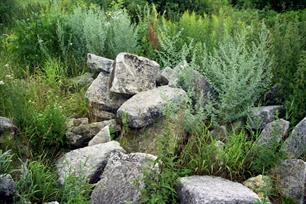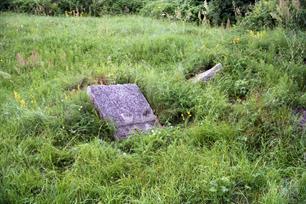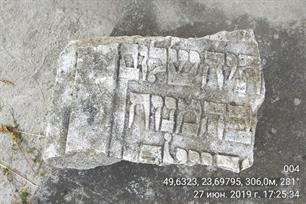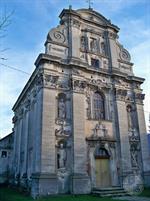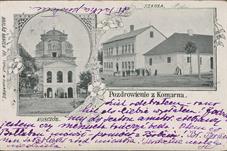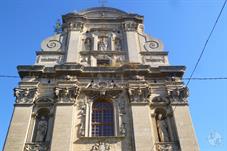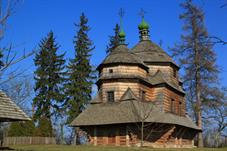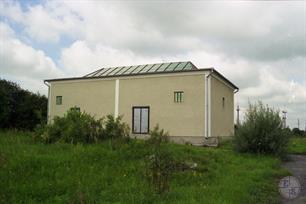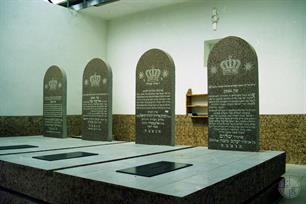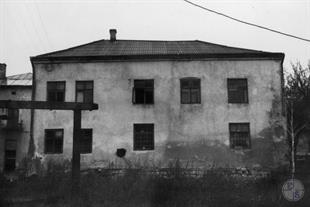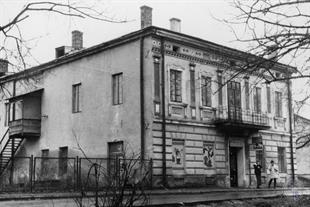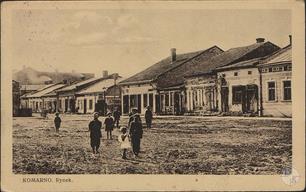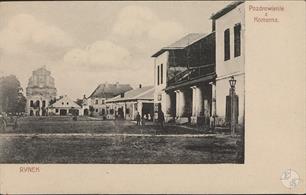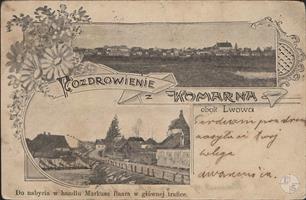Komarno
Lviv district, Lviv region
Sources:
- Russian Jewish encyclopedia
- YIVO Institute for Jewish Research. Zhidachov-Komarno Hasidic Dynasty
Photo:
- Jewish Cemeteries Initiative. Komarno Jewish Cemetery
- Boris Khaimovich, Center for Jewish art. Komarno
- Biblioteka Narodowa Polona. Komarno
- Romankravchuk, Myrko Galizien, Neovitaha777 - Wikipedia, sight of Komarno
- Russian Jewish encyclopedia
- YIVO Institute for Jewish Research. Zhidachov-Komarno Hasidic Dynasty
Photo:
- Jewish Cemeteries Initiative. Komarno Jewish Cemetery
- Boris Khaimovich, Center for Jewish art. Komarno
- Biblioteka Narodowa Polona. Komarno
- Romankravchuk, Myrko Galizien, Neovitaha777 - Wikipedia, sight of Komarno
Komarno (ukr. Комарно), city (since 1940) in Lviv region.
Founded in 13th century. In 16-18 centuries - as part of the Commonwealth. In 19 - beginning. 20th century -In the province of Galicia in Austria-Hungary.
In 1919–39 - as part of Poland, in 1939–91 - USSR.
Founded in 13th century. In 16-18 centuries - as part of the Commonwealth. In 19 - beginning. 20th century -In the province of Galicia in Austria-Hungary.
In 1919–39 - as part of Poland, in 1939–91 - USSR.
In 1902, in Komaro was founded the Zionist Organization Dorsheh Zion.
In 1916, 9 Jews were sent from Komaro to Tarnopol.
In 1919, a school was opened with teaching in Hebrew.
In the beginning of 1920s in Komaro with the help of Joint, the bank was founded.
In 1920, the Talmud Torah began to work, in mid-1920s - school for girls "Beis Yaakov".
In mid-1930s Yeshiva was open.
In 1920-30s branches of various Jewish parties and organizations acted in Komaro.
In 1916, 9 Jews were sent from Komaro to Tarnopol.
In 1919, a school was opened with teaching in Hebrew.
In the beginning of 1920s in Komaro with the help of Joint, the bank was founded.
In 1920, the Talmud Torah began to work, in mid-1920s - school for girls "Beis Yaakov".
In mid-1930s Yeshiva was open.
In 1920-30s branches of various Jewish parties and organizations acted in Komaro.
In 1563 in Komarno lived approx. 10 Jews,
in 1765 - 686,
in 1880 - 2084 (40.9% of the total population),
in 1900 - 2507 (c. 50% of the total population),
in 1910 - 2716 (44.2% of the total population),
in 1921 - 2004 (40% of the total population),
in 1931-2390 Jews.
The Jews lived in Komarno since the 1530s. In 1550, the Jews of Komarno received from Polish King of the privilege that expanded Jewish self -government.
In the beginning 17th century an independent community was organized in Komarno.
In 1620, the construction of a stone synagogue began, in 1644 a Jewish cemetery was founded.
In 1648, the population of Komarno, including Jews, resisted the troops of B.M. Khmelnitsky, besieging the city. During the siege, many Jews died.
In the 17-18 centuries the main affairs of Jews in Komarno - crafts, mainly shoe (out of 147 shoemakers, more than 50% are Jews).
In the 1st half of 18th century rabbi in Komarno was Menacham-Pinhos Gorovitz, in 1764-77 - Meir Margulius, then-Yakov Baness and Arye-Faybush Kagana, in the beginning of 19th century - Mordhe Gilberhstam, in the 1810s - Jehoshua-Heshel Frenkel-Teumim, from 1827 - Eliezer-Simha Vieteles.
After the death of the latter, his son-in-law Mordhe-Iskhok Glanz took his place, in mid. of 19th century - Shimon Tenea.
In 1898–1927, rabbi in Komarno was son-in-law of M.-I. Ghanz Yakov-Isroel Langenaer, in 1927–41 - the son of the last Efroim-Doiv.
in 1765 - 686,
in 1880 - 2084 (40.9% of the total population),
in 1900 - 2507 (c. 50% of the total population),
in 1910 - 2716 (44.2% of the total population),
in 1921 - 2004 (40% of the total population),
in 1931-2390 Jews.
The Jews lived in Komarno since the 1530s. In 1550, the Jews of Komarno received from Polish King of the privilege that expanded Jewish self -government.
In the beginning 17th century an independent community was organized in Komarno.
In 1620, the construction of a stone synagogue began, in 1644 a Jewish cemetery was founded.
In 1648, the population of Komarno, including Jews, resisted the troops of B.M. Khmelnitsky, besieging the city. During the siege, many Jews died.
In the 17-18 centuries the main affairs of Jews in Komarno - crafts, mainly shoe (out of 147 shoemakers, more than 50% are Jews).
In the 1st half of 18th century rabbi in Komarno was Menacham-Pinhos Gorovitz, in 1764-77 - Meir Margulius, then-Yakov Baness and Arye-Faybush Kagana, in the beginning of 19th century - Mordhe Gilberhstam, in the 1810s - Jehoshua-Heshel Frenkel-Teumim, from 1827 - Eliezer-Simha Vieteles.
After the death of the latter, his son-in-law Mordhe-Iskhok Glanz took his place, in mid. of 19th century - Shimon Tenea.
In 1898–1927, rabbi in Komarno was son-in-law of M.-I. Ghanz Yakov-Isroel Langenaer, in 1927–41 - the son of the last Efroim-Doiv.
In the late eighteenth centuriy in Komarno was founded Hasidic dynasty. Its tsadikim (lit., “righteous ones”), renowned for their esoteric learning and even purportedly for performing miracles, attracted many disciples. The dynasty continues to exist, primarily in the United States, although many of its members and leaders were murdered during the Holocaust.
The first of the dynasty, Tsvi Hirsh of Zhidachov (Yid., more properly Zhidetshoyv; 1763–1831), was one of the most important Galician tsadikim of his day. He was the eldest of the five sons of Rabbi Yitshak Ayzik Eichenstein (d. 1800). Tsevi Hirsh’s brothers were also learned rabbis and authors: Mosheh of Sambor; Aleksander-Sender of Komarno (Yid., more properly Kmarne; d. 1818), rabbi of Zhidachov, Zhuravno, and Komarno; Lippa of Sambor, who died young; and Yisakhar Ber (Berish) of Zhidachov.
Tsvi Hirsh had no male descendants, and after his death him successor became Yitshak Ayzik Yehudah (1806–1874), Aleksander-Sender’s son.
Yitshak Ayzik Yehudah Yehi’el of Komarno was the most interesting and original of the dynasty’s leaders in its second generation. In effect, he founded a new Hasidic dynasty, that of Komarno, and was known by the name Safrin, whereas other members of the family were called Eichenstein. After his marriage he studied with his father-in-law, Avraham Mordekhai of Pińczуw, but when his teacher died he became a prominent disciple of his uncle, Tsvi Hirsh. Eventually the dynasty was known by the double name Zhidachov-Komarno.
The first of the dynasty, Tsvi Hirsh of Zhidachov (Yid., more properly Zhidetshoyv; 1763–1831), was one of the most important Galician tsadikim of his day. He was the eldest of the five sons of Rabbi Yitshak Ayzik Eichenstein (d. 1800). Tsevi Hirsh’s brothers were also learned rabbis and authors: Mosheh of Sambor; Aleksander-Sender of Komarno (Yid., more properly Kmarne; d. 1818), rabbi of Zhidachov, Zhuravno, and Komarno; Lippa of Sambor, who died young; and Yisakhar Ber (Berish) of Zhidachov.
Tsvi Hirsh had no male descendants, and after his death him successor became Yitshak Ayzik Yehudah (1806–1874), Aleksander-Sender’s son.
Yitshak Ayzik Yehudah Yehi’el of Komarno was the most interesting and original of the dynasty’s leaders in its second generation. In effect, he founded a new Hasidic dynasty, that of Komarno, and was known by the name Safrin, whereas other members of the family were called Eichenstein. After his marriage he studied with his father-in-law, Avraham Mordekhai of Pińczуw, but when his teacher died he became a prominent disciple of his uncle, Tsvi Hirsh. Eventually the dynasty was known by the double name Zhidachov-Komarno.
In September 1939, troops of the Wehrmacht occupied Komaro. Several Jews were killed.
After 2 weeks, troops of the Red Army entered Komaro.
In the end of 1939, a school with teaching in Yiddish was opened in Komaro.
On June 30, 1941, the Wehrmacht troops again occupied the town. Judenrat and a Jewish working camp were created.
In the end of 1941, 470 Jews were shot in the Bereznyak forest.
In July 1942, about 1800 Jews remained in Komarno.
In November 1942, part of the Jews was deported to the Belzhets death camp, the remaining were resettled to the ghetto Rudkov.
Of the hidden Jews, 61 people were shot at the Jewish cemetery.
After 2 weeks, troops of the Red Army entered Komaro.
In the end of 1939, a school with teaching in Yiddish was opened in Komaro.
On June 30, 1941, the Wehrmacht troops again occupied the town. Judenrat and a Jewish working camp were created.
In the end of 1941, 470 Jews were shot in the Bereznyak forest.
In July 1942, about 1800 Jews remained in Komarno.
In November 1942, part of the Jews was deported to the Belzhets death camp, the remaining were resettled to the ghetto Rudkov.
Of the hidden Jews, 61 people were shot at the Jewish cemetery.

- Home
- Shtetls
- Vinnytsia region
- Volyn region
- Dnipro region
- Donetsk region
- Zhytomyr region
- Zakarpattia region
- Zaporizhzhia region
- Ivano-Frankivsk region
- Kyiv region
- Kropyvnytskyi region
- Luhansk region
- Lviv region
- Mykolayiv region
- Odessa region
- Poltava region
- Rivne region
- Sumy region
- Ternopil region
- Kharkiv region
- Kherson region
- Khmelnytskyi region
- Chernihiv region
- Chernivtsi region
- Cherkasy region
- Crimea
- Synagogues
- Cemeteries
- Objects & guides
- Old photos
- History
- Contact
Jewish towns of Ukraine
Jewish towns of Ukraine
My shtetl
My shtetl
Donate
